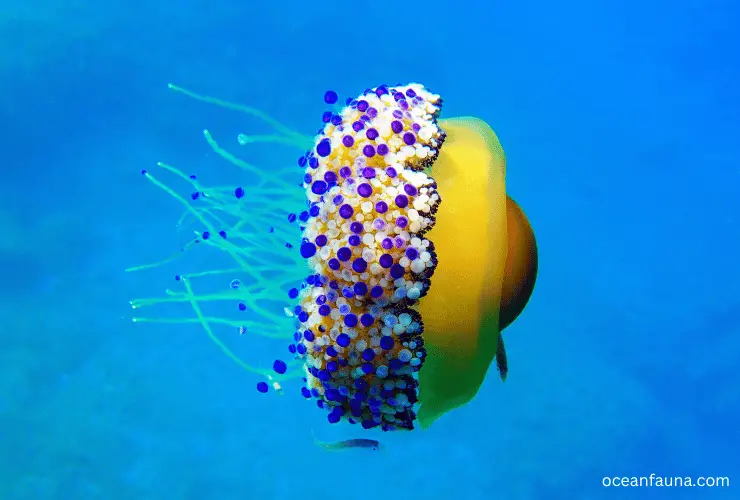Fried egg jellyfish is one of the fascinating water creatures. It is also known as Egg-Yolk jellyfish. It belongs to the phylum Cnidaria. These are smaller jellyfish and are mostly found in the Pacific Ocean. They have distinctive yellow bell-shaped bodies.
The tentacles of fried egg jellyfish are delicate. These are favorites among beachgoers and aquarium enthusiasts alike. These are known to deliver a painful sting to humans.
But still, these are not considered dangerous marine creatures. Their unique appearance and gentle swimming movements are making a popular addition to aquariums all over the world.
Have you ever encountered a Fried Egg Jellyfish in the wild? Do you know how these amazingly interesting creatures grow and reproduce? If you have the curiosity to learn more about these jiggly marine animals, then read on!
We are exploring the world of facts about Egg-Yolk Jellyfish in this article. So, grab a cup of coffee, sit back, eat snacks, and join us on a journey of discovery!
About Fried Egg Jellyfish – A Quick Biology
Here is a quick biology table that you can review for getting depth information within a matter of seconds:
| Parameters | Details |
| Scientific name | Phacellophora camtschatica |
| Kingdom | Animalia |
| Family | Phacellophoridae |
| Genus | Phacellophora |
| Phylum | Cnidaria |
| Class | Scyphozoa |
| Order | Semaeostomeae |
| Species | P. camtschatica |
| Habitat | These jellyfish like to spend their lives at shallow depths. The depths do not exceed 50 meters. |
| Life Span | Half a year or hardly one year |
| Diet | Zooplankton and many other jellyfish |
| Geography | Western Atlantic Ocean, Mediterranean, and Pacific Ocean, |
Fried Egg Jellyfish Fun Facts
Here are some amazing fun facts about this yummiest and the cutest fried egg jellyfish given by our Reddit colleagues:
- The fried egg jellyfish often remains still. It moves slowly by contracting and relaxing its bell while drifting in the water.
- The jellyfish has dark purple tentacles that contain stingers. These stingers can pose little harm to humans. In fact, small fish seek refuge in these tentacles in the vast sea.
- Jellyfish have been around for more than 500 million years and are the earliest multi-organ animal group.
- They possess a single opening that serves both as a mouth and anus.
- We know that fried egg jellyfish typically spends a considerable amount of time still. Still, it is capable of active swimming.
- The lifespan of Fried Egg Jellyfish is limited to approximately six months. It starts in summer and ends in winter.
- The fried egg jellyfish can be mainly found in the Mediterranean, Adriatic, and Aegean Seas. They also occasionally venture into the Atlantic Ocean.
- Cotylorhiza tuberculata is one of the species that is also known as Fried Egg Jellyfish. It is observed frequently in the Mediterranean Sea. On the other hand, Phacellophora camtschatica is another species known as Fried Egg Jellyfish. It can be found globally and is much larger.
- It eats its prey just like sea nettles and moon jellyfish. It takes on the color of its prey. This is quite an intriguing fact.
- Its reproductive tissue is yellowish. However, it changes with its diet.
- Its body contains more than 95 to 98 percent water. This is definitely a shocking fact.
- Fried egg jellyfish have separate sexes. It has two main stages of reproduction. These include a free-swimming medusa stage and an attached polyp stage.
First Sightings of ‘Fried Egg’ Jellyfish
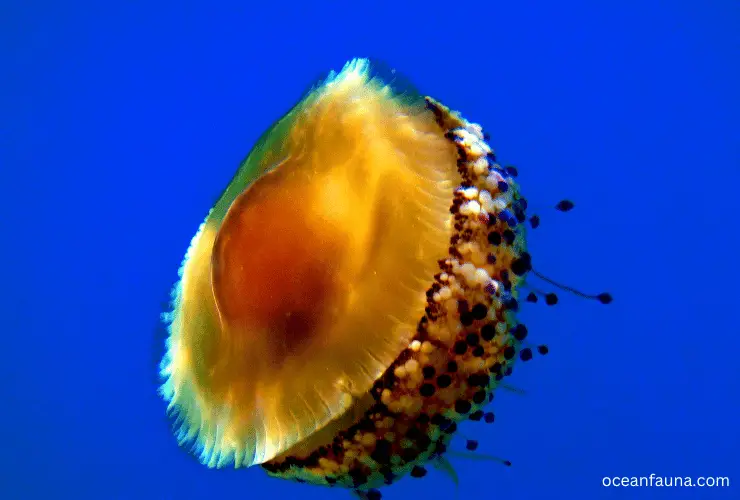
The ‘Fried Egg’ Jellyfish was first sighted in the Mediterranean Sea in 2003. Since then, it has been spreading across various regions of the sea.
In 2012, researchers from the University of Malta recorded their first sightings of the ‘Fried Egg’ jellyfish. It was observed in the waters surrounding the Maltese Islands. This species has been sighted in large numbers during the summer months.
It also indicates a possible seasonal migration pattern. The researchers noted that the jellyfish’s population is growing, and its range is expanding. It could impact the ecosystem in the Mediterranean. These findings were published in an article by the Oceania journal.
Description And Distribution of Fried Egg Jellyfish
According to the San Diego Natural History Museum, the Fried Egg Jellyfish is a cool-water species of jellyfish. It can be found in many parts of the world’s oceans. Still, it is relatively low in abundance. It dominates in the southern part of the Sea of Japan and the Sea of Okhotsk near the shore (especially the southern part). It can be found in isolation elsewhere. (Source)
You can also find them in the western and eastern Bering Sea. Northern California currents also constitute a big proportion of these jellies. In a study in 2011, this jellyfish was found to prefer deeper waters due to its bell size. It ranges from 5-59 cm.
The deeper waters enable it to swim against strong water currents and pressure. They move faster during the day and flood tides. Vertical migrations are used to enter the hypoxia zone. And what about shallow waters? Only a significant quantity was investigated in shallow waters. It was only found near west Kamchatka.
These jellyfish reside below the pycnocline and avoid crossing the boundary layer. But they can dive into the hypoxic layer during the day when competition is high. The Fried Egg Jellyfish can withstand low oxygen levels for several hours.
Other species move away from low oxygen zones. This is why fried egg jellyfish is a unique and special species.
Increased tolerance to detrimental factors leads to an increase in jellyfish populations. It plays a significant role in the food web and can serve as an indicator of ecosystem structure and function. The negative impact on ecosystem services increases as the jellyfish population grows.
From NCBI research, we’ve discovered fascinating facts about the description and distribution of fried egg jellyfish.
- This peculiar species is mostly found in the cold North Pacific but also occurs in the following regions:
- NW Atlantic
- Mediterranean
- Arctic
- East and South Pacific
- E, SW, and NE Atlantic
- Recently, sightings have intensified in the Azores Islands, Macaronesia, the Iberian Peninsula, and the Mediterranean.
- DNA barcoding revealed three (potentially four) cryptic species within the Phacellophora camtschatica complex. It has two co-occurring in the North Pacific and one or two in the North Atlantic and Mediterranean. Further inspections are needed to validate the identity of the cryptic taxa detected.
- They are high genetic relatedness of Phacellophora from the cold NW Atlantic and sub-tropical shores of the Azores. It suggests a recent invasion of the temperate NE Atlantic. Their medusivorous habits could relate to the recent reports of Phacellophora in the Azores, Madeira, Canary Islands, and the Mediterranean.
More investment and monitoring are necessary to catalog and understand jellyfish dynamics worldwide.
Appearance of Fried Egg Jellyfish
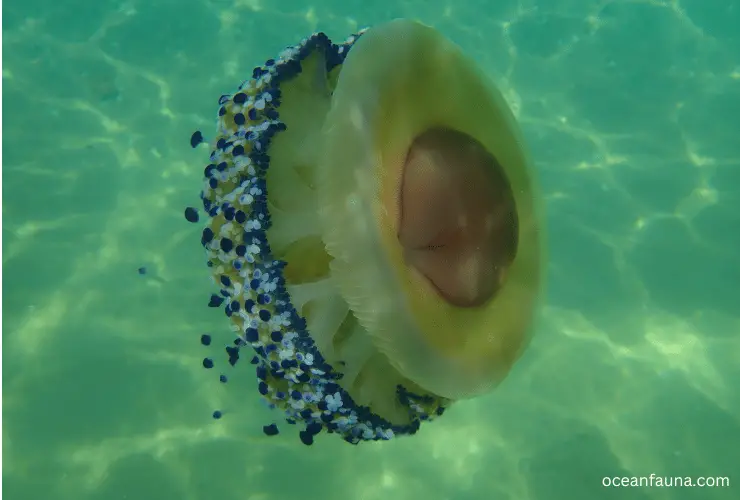
According to the National Marine Sanctuary Foundation, Fried egg jellyfish can be identified easily with their yellow-colored body. This is another reason it’s called an egg-yolk jellyfish due to its yolk-like appearance. It is known as one of the large species of jellyfish.
Here are a few other physical characteristics of this jelly given by the OCEANA
organization:
- 60 cm (2 ft.) diameter bell
- 16 clusters of about a few dozen tentacles
- Tentacles are 6 m long (20 ft.)
The bell can reach up to 60 cm in diameter. This physical characteristic makes it one of the largest jellyfish species in the world. The bell of the fried egg jellyfish is smooth and dome shaped. It has a slightly flattened top and bottom.
The oral arms, which are used to capture prey, are broad and thin. These arms resemble curtains hanging down from the bell’s margin. These oral arms are often frilly and have a wavy edge. It adds to the jellyfish’s ornate appearance.
The tentacles of the fried egg jellyfish are arranged in 16 linear clusters around the bell’s margin. Each cluster can have hundreds of short, sticky tentacles. These are used to catch and subdue prey. The tentacles can extend to several meters in length. It makes them longer than the bell’s diameter.
Overall, the fried egg jellyfish has a mesmerizing and beautiful appearance. It is a bright yellow center and delicate, lace-like arms and tentacles make it more beautiful. However, despite its graceful appearance, the jellyfish should be approached with caution as it can still sting.
Important Note: Cotylorhiza tuberculata is a smaller specie of this jellyfish and it’s also known as fried egg jellyfish. It’s also sometimes mistakenly taken as Lion’s mane jellyfish due to its resemblance with it.
Behavior of Fried Egg Jellyfish
Fried egg jellyfish exhibit a variety of behaviors in response to their environment. They are known to swim in a pulsing motion. It means they can contract their bell and expel water to move forward. This motion is also used to capture prey by creating a water current that brings food toward their tentacles.
Fried egg jellyfish are also able to change their orientation in response to light. For example, their yellow center acts as a photoreceptor. They are known to exhibit phototaxis, or movement towards a light source. This behavior may be used to locate prey or avoid predators.
Additionally, fried egg jellyfish are capable of regeneration. This behavior allows them to recover from damage to their bell or tentacles. They are also able to adjust their size based on the availability of food. For example, larger individuals can be found in areas with abundant prey.
Thus, the creature has minimal mobility and primarily drifts. It relies on suspension feeding for sustenance. This behavior is also common among Cnidaria. If we talk about its reproductive behavior, then it is just also as amazing as beyond our imagination. Overall, the behaviors of fried egg jellyfish are shaped by their environment and the need to survive and reproduce.
Habitat And Range of Fried Egg Jellyfish
Fried egg jellyfish prefer to live in the open ocean. They can be found in both warm and cold waters. These jellyfish are often seen near the surface of the water.
These sea jellies can grow to be quite large, with some individuals reaching up to two feet in diameter. They are capable of long-distance migrations, often following the prevailing currents to different areas.
The fried egg jellyfish is a pelagic species. What does it mean? It means it lives in the open ocean away from the seafloor. They are commonly found in the epipelagic zone.
It is the top 200 meters of the water column where there is sufficient sunlight for photosynthesis to occur. However, they can also be found at deeper depths.
Feeding/Diet of Fried Egg Jellyfish
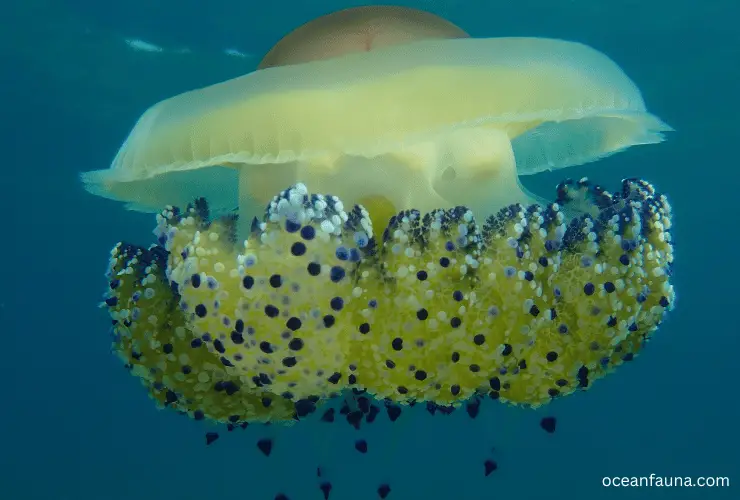
Fried egg jellyfish fulfill their nutritional needs from plankton and medusae. It does not leave the tentacles and it eats them too. It eats them without crushing them and puts them into their mouths.
These jellyfish have different digestive systems that digest food that’s not crushed in the mouth. Their food can be digested with the help of digestive enzymes. These are present in the gastrovascular cavity.
Fried egg jellyfish (Phacellophora camtschatica) is a generalist predator that feeds on a variety of taxa. It may include euphausiids, cladocerans, and decapod zoea. It is also known to prey on fish and other jellyfish species, such as:
- Aurelia spp.
- Ctenophores
- Pelagia noctiluca
Interestingly, this jellyfish also eats the larvae of fish. It is also known as cannibalistic species as it eats/consumes individuals of its own kind.
Reproduction System of Fried Egg Jellyfish
Have you ever wondered how the fried egg jellyfish grows and reproduces? Well, we have some fascinating information for you!
The jellyfish begins its life as a fertilized egg. It then develops into a planula covered in cilia. The planula settles and transforms into a polyp stage called scyphistomae. It happens after swimming for several days.
The jellyfish undergoes several stages of development during the polyp stage. It happens with different numbers of tentacles. The jellyfish reproduces asexually through side budding and strobilating once it is mature.
Now, the ephyrae (or immature jellyfish) will be released. They have a cruciform mouth and nematocyst batteries scattered throughout their bodies.
Their tentacles elongate, additional tentacles form and their oral arms elongate whenever the ephyrae mature. The jellyfish’s gastric system develops in a centrifugal direction.
Sexual maturity is achieved after about 9 months. Its reproduction can occur in the water column. This process repeats throughout the jellyfish’s life cycle. It alternates between the asexual polyp stage and the sexual medusa stage.
Thus, the reproductive system of egg-yolk jellyfish is very interesting. It’s also well-documented. Its life cycle is not different from other members of the Scyphozoa class. We can say that it transitions between asexual polyps and sexual medusa. It also has distinct forms for each reproduction method. (source)
Cardiovascular And Nervous System of Fried Egg Jellyfish
Let’s discuss the egg-yolk jellyfish’s cardiovascular and nervous systems separately:
Cardiovascular System
The cardiovascular system of the fried egg jellyfish is relatively simple. It does not have a heart or circulatory system. The jellyfish relies on the diffusion of oxygen and nutrients through its thin tissues. The gastrovascular cavity of the jellyfish serves as both a digestive and circulatory system.
Its cavity is filled with seawater. It is drawn in through the mouth and expelled through the anus. Nutrients are absorbed by the jellyfish’s tissues as the seawater circulates through the cavity. Waste products are also expelled through the anus.
Nervous System
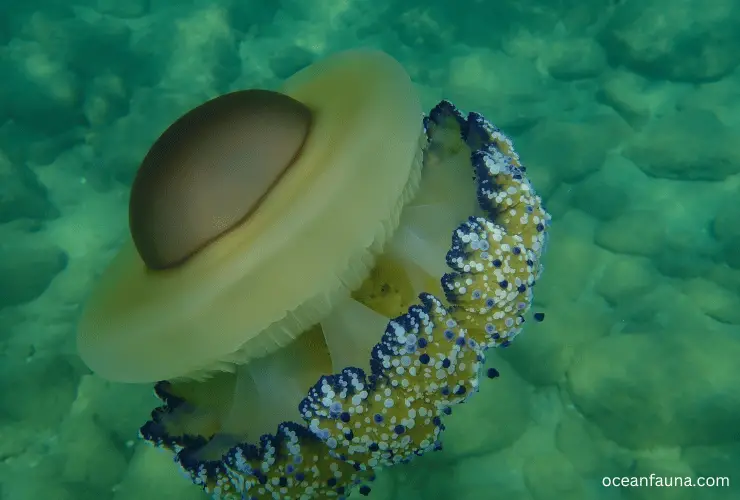
The nervous system of the fried egg jellyfish is similarly essential. It does not have a brain or centralized nervous system. The jellyfish has a nerve net that runs throughout its body.
The neurons are spread out in a diffuse network. These neurons allow the jellyfish to sense its environments, such as changes in light or water flow.
The jellyfish also have specialized sensory structures called rhopalia. It contains statocysts to detect gravity and balance, as well as ocelli to detect light. The jellyfish uses its nervous system to coordinate movement, such as:
- Swimming or responding to stimuli
- Controlling its stinging cells
The stinging cells, or cnidocytes, are controlled by specialized nerve cells called cnidoblasts. These cells can contract the stingers in response to a stimulus.
Anatomy of the Fried Egg Jellyfish
From research, we have found that the fried egg jellyfish belongs to the Scyphozoa class. Its family is Phacellophoridae. Its unique anatomy includes
- A distinct yellow center that resembles a broken egg yolk surrounded by opaque, white tissue.
- A gastric cavity with radial canals that join a marginal ring canal.
- Broad and curtain-like oral arms
- Subumbrellar tentacles arranged in 16 linear clusters.
The Phacellophoridae family was created for this species. It is because it serves as an intermediate between Cyaneidae and Ulmaridae. However, recent phylogenetic analyses suggested something new. It stated that the genus Phacellophora is a member of the Ulmaridae family.
It is worth noting that there is evidence of cryptic diversity within the Phacellophora genus. It is found with at least three or four distinct species.
Ecology
Did you know that fried egg jellyfish play an important role in the marine ecosystem? Obviously, it does! Let’s discover how it plays a vital role in the ecosystem. These jellies are found in pelagic waters throughout the world. These are often seen in large numbers during the summer months.
They serve as a source of food for a variety of predators. Additionally, fried egg jellyfish are known to feed on a wide range of organisms. This makes them a key link in the food chain. So, it helps to maintain a healthy balance in the ocean.
In terms of reproduction, fried egg jellyfish have a complex life cycle. It involves both sexual and asexual stages. Overall, the unique anatomy, feeding habits, and life cycle of this unique creature are very interesting. This makes it a fascinating subject of study for marine biologists and ocean enthusiasts alike.
Predators of Fried Egg Jellyfish
The predators of egg-yolk jellyfish include sea turtles, sunfish, and spiny dogfish. Some seabirds, such as the common murre, are also the enemies of these sea jellies. Additionally, crustaceans and some species of fish have also been observed feeding on jellyfish.
Here is a table summarizing some of the known predators of fried egg jellyfish:
| Predator | Species |
| Sea turtle | Green sea turtle, leatherback turtle |
| Sunfish | Mola mola, masturus lanceolatus |
| Spiny dogfish | Squalus acanthias |
| Seabirds | Common murre, black-legged kittiwake |
| Fish | Chum salmon, Northern anchovy, Pacific herring |
| Crustaceans | Dungeness Crab, blue crab, rock crab |
It’s worth noting that some of these predators may only feed on fried egg jellyfish opportunistically. On the other hand, other predators may specifically target them as a major food source. Additionally, some predators may avoid them altogether. It is because fried egg jellyfish are capable of producing a mild sting that can cause a major problem.
Symbiotic Relationship
The Fried Egg Jellyfish can host symbionts that transfer onto P. camtschatica when consumed. It has a weak sting. So, it allows for various parasites and crustaceans like larval crabs and Hyperia medusarum to ride on its bell.
They can even steal food from their oral arms and tentacles. These feeding habits make the fried egg jellyfish an important player in marine ecosystems as both a predator and a host for other species. This process is also known as a symbiotic relationship.
Does a Fried Egg Jellyfish Sting Hurt?
Yes. The sting of a fried egg jellyfish can hurt. However, it is generally considered mild. It does not cause much harm to humans. The tentacles of this jellyfish contain stinging cells called nematocysts. These are used for self-defense and immobilizing prey.
However, these nematocysts are not potent enough to cause serious harm to humans and other living organisms. Their stings usually result in only minor discomfort or a mild rash. Now what to do if someone is stung by this sea jelly? It is important to seek medical attention immediately if you experience severe symptoms.
To treat a jellyfish sting, follow the following instructions:
- The affected area should be rinsed with vinegar to remove any remaining tentacles.
- If vinegar is not available, salt water can be used.
- Do not rinse with fresh water, as this can make the stingers release more venom.
- It is also recommended to immerse the affected area in hot water for 20-45 minutes. This can help to alleviate pain. It also prevents further venom from being released.
- Over-the-counter pain medications and topical creams may also help to relieve symptoms.
If you experience a severe allergic reaction or difficulty breathing, seek emergency medical attention immediately!
Are Fried Egg Jellyfish Rare?
No. Fried egg jellies are not considered rare. It is the most common species of jellyfish. However, their populations can be affected by environmental factors such as:
- Pollution
- Climate change
- Overfishing
- Habitat loss
- Invasive species
- Ocean acidification
- Entanglement in marine debris
All these factors can pose a threat to its population.
How Big Can a Fried Egg Jellyfish Get?
The size and weight can vary depending on the species and the age of the jellyfish. However, let’s see the approximate size and weight of these kinds and cute jellies:
● Fried egg jellyfish size
Fried egg jellyfish can grow up to 35 centimeters in diameter.
● Fried egg jellyfish weight
They can weigh up to 3 kilograms.
Fried Egg Jellyfish Hunts in a Swarm of Aurelia
In a fascinating video by BBC Earth, it is shown how the Fried Egg Jellyfish hunt in a swarm of Aurelia. These are also commonly known as moon jellies.
The video depicts how the Fried Egg Jellyfish uses its oral arms to sweep the water around the moon jellies. It forces them to swim toward the jellyfish’s bell, where they get trapped by its tentacles.
The moon jellies’ motion is then synchronized to the pulsing of the Fried Egg Jellyfish. This helps it propel through the water while the moon jellies are held captive. This unique hunting behavior is not commonly observed. This video has given a rare insight into the predatory nature of the Fried Egg Jellyfish.
The Ultra-High Adsorption Capacity of Fried Egg Jellyfish
The fried egg jellyfish may have a new purpose beyond being a fascinating marine creature. Researchers have found that a material similar in structure to the jellyfish has an ultra-high adsorption capacity.
This can be used for removing lead from aqueous solutions. In a study published on ResearchGate, a team of scientists developed g-AlOOH/Boehmite/SiO2/Fe3O4 microspheres. These microspheres mimic the structure of the jellyfish.
These microspheres demonstrated an adsorption capacity that was four times higher than the commercial adsorbent. The research suggests that the fried egg jellyfish-like microspheres could be an efficient material for lead removal from water. It is also cost-effective.
FAQs
Is the fried egg jellyfish real?
Yes, the fried egg jellyfish is real. It is a species of jellyfish called Phacellophora camtschatica. You can easily find these species in the northern Pacific Ocean.
These are living particularly in the waters of the western coast of North America. These species have been studied extensively and are well-documented in scientific literature.
Is the fried egg jellyfish poisonous?
Yes. Fried egg jellyfish are poisonous. However, it is not considered to be highly poisonous to other animals and humans. Although it does have stingers, the venom is not very strong.
Its sting generally has a mild effect on the victim. It is always best to avoid contact with these sea jellies. It is because some individuals may have an allergic reaction or be more sensitive to venom.
What do Fried egg jellyfish do?
Fried Egg Jellyfish are passive creatures that spend most of their time floating in the water. They pulsate their bell slowly to move around and feed on small organisms like plankton and fish larvae. They can also actively swim when necessary.
What is the most commonly seen egg yolk jellyfish in the editerranean Sea?
Cotylorhiza tuberculata is the most commonly seen egg yolk jellyfish in the Mediterranean Sea. This is the common species of fried egg jellyfish that can frequently be spotted in this sea.
How many Fried Egg Jellyfish are around the world?
There is no exact count of the number of fried egg jellyfish around the world. It is because they are difficult to track due to their short lifespan and they tend to drift with ocean currents.
Conclusion
So, we have tried the cover the entire story of egg-yolk jellies. Wait, one fact is still missing. Are Fried Egg Jellyfish endangered? Its conservation status is listed as “Least Concern” by the International Union for Conservation of Nature (IUCN). However, it is important to continue monitoring their population. It also takes necessary conservation measures to ensure their survival.

